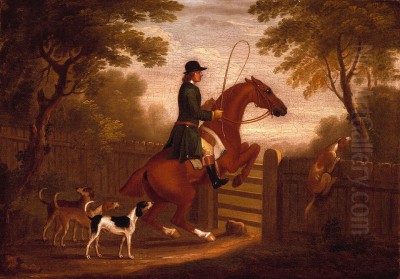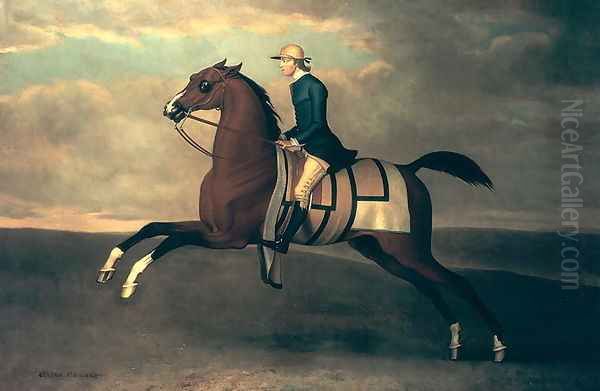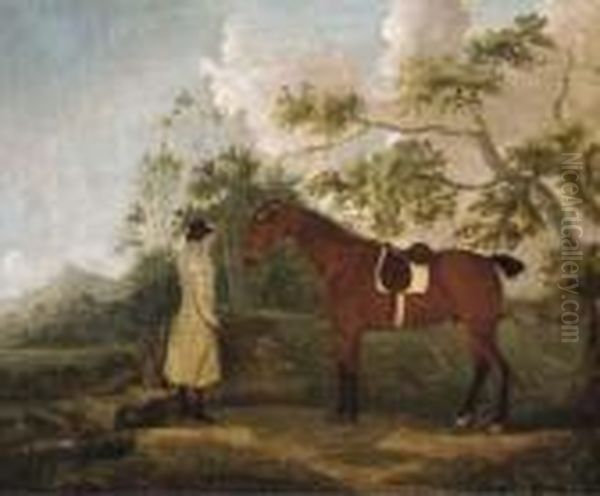
James Seymour stands as a foundational figure in the history of British art, particularly noted as one of the earliest native-born painters to dedicate his career almost exclusively to the depiction of sporting subjects. Born in London in 1702 and dying there in 1752, his life spanned a crucial period in the development of British culture, witnessing the rise of organised horse racing and the increasing prominence of country sports among the landed gentry and aristocracy. Seymour's meticulous, if sometimes stylistically naive, portrayals of horses, racing scenes, and hunts provide invaluable visual documentation of these pursuits in the first half of the eighteenth century.
Though perhaps overshadowed in anatomical accuracy and painterly sophistication by later masters like George Stubbs, Seymour's contribution was vital. He helped establish sporting art as a legitimate and popular genre in Britain, catering to a growing market of patrons eager to see their prized animals and favourite pastimes immortalised. His work captured the essence of the sporting life, from the sleek lines of a thoroughbred racehorse to the bustling activity of the stable yard and the thrill of the chase.
Early Life and Artistic Formation
James Seymour was born into advantageous circumstances in London. His father, also named James (sometimes referred to as James Seamer or even, possibly erroneously in some sources, James d'Israeli), was a prosperous figure involved in banking, goldsmithing, and the diamond trade. Crucially for the young Seymour's future, his father was also an amateur artist and an avid collector and dealer of art, particularly prints and drawings. This environment undoubtedly exposed the budding artist to a wide range of visual material from a young age.
Unlike many of his contemporaries who sought formal training in established studios or travelled to Italy, James Seymour appears to have been largely self-taught. He honed his skills by studying and copying the works in his father's extensive collection. This collection likely included prints by established masters, potentially including works by European animal and landscape artists, as well as earlier British artists like Francis Barlow, known for his illustrations of Aesop's Fables and sporting scenes, or the detailed topographical prints of Wenceslaus Hollar.

While some accounts suggest informal guidance from figures like the draughtsman Francis Place, the primary engine of Seymour's artistic education seems to have been his own diligent observation and practice, fuelled by the resources his father provided. This self-directed learning path may account for certain characteristics of his style – a strong emphasis on line and detail, sometimes coupled with a less sophisticated handling of perspective or atmospheric effects compared to academically trained painters. His father's connections also likely provided early introductions to potential patrons within London's wealthy circles.
The Context: Sporting Art in Early Georgian Britain
Seymour emerged as an artist during a period when 'sporting art' was coalescing into a distinct genre in Britain. The early eighteenth century saw the consolidation of horse racing under the patronage of the monarchy and aristocracy, with Newmarket solidifying its position as the headquarters of the turf. Fox hunting was also becoming increasingly organised and fashionable. These activities were central to the lifestyle and social identity of the landed classes.
This created a demand for artists who could accurately and flatteringly depict these pursuits. Patrons wanted portraits of their champion racehorses, records of famous matches, scenes of successful hunts, and images that celebrated their connection to the countryside and its traditions. Before Seymour, the field was relatively small, often dominated by artists of foreign origin like Peter Tillemans, who painted topographical views that often included sporting activities, and John Wootton, who became the most established sporting painter of the generation preceding Seymour.
Wootton, in particular, set a high standard with his large-scale, often classically inspired compositions of racing and hunting scenes, as well as equestrian portraits. Seymour entered this developing market, offering a style that, while perhaps less grand than Wootton's, possessed a directness and attention to specific detail that appealed greatly to patrons primarily interested in accurate likenesses of their horses and recognisable depictions of sporting events.
Seymour's Artistic Style and Technique
James Seymour's style is characterised by its clarity, meticulous detail, and focus on the accurate representation of his primary subject: the horse. He possessed a keen eye for equine conformation and could capture the individual characteristics of specific animals, a skill highly valued by his patrons. His horses are often depicted in profile or near-profile, allowing for a clear view of their lines, reminiscent of the compositions found in contemporary prints.

His draughtsmanship was strong, forming the backbone of his work. Many of his surviving works are drawings, executed in pencil, pen and ink, often with watercolour or wash added. These drawings range from quick sketches capturing movement to highly finished studies. They reveal his working method, focused on careful observation and linear definition. His oil paintings often retain this emphasis on line, with forms clearly delineated and local colour applied carefully within the outlines.
Compared to the more painterly and atmospheric approach of John Wootton, Seymour's work can sometimes appear somewhat stiff or flat. His compositions are often straightforward, lacking the complex spatial arrangements or dramatic lighting found in the work of some contemporaries like William Hogarth, whose narrative scenes explored different facets of London life. However, Seymour's strength lay not in dramatic invention but in faithful recording. His depiction of tack, stable fittings, jockey silks, and the specific settings of places like Newmarket Heath provides a wealth of documentary information.
While an early influence from the Flemish master Sir Anthony van Dyck is sometimes mentioned, this is likely an indirect influence absorbed through prints or the general tradition of equestrian portraiture that Van Dyck had so masterfully advanced in the previous century, rather than direct stylistic emulation. Seymour's focus remained firmly rooted in the specific realities of the British sporting world.
Key Themes and Subjects
The horse was the undisputed star of James Seymour's oeuvre. He specialised in portraying the leading racehorses of his day, animals whose lineage and performance were matters of intense interest and significant financial investment for their owners. His most famous subject is undoubtedly 'Flying Childers', an undefeated racehorse owned by the Duke of Devonshire, considered one of the first truly great thoroughbreds. Seymour painted Flying Childers multiple times, establishing an iconic image of the horse that was widely reproduced in engravings.
Beyond individual horse 'portraits', Seymour excelled at depicting the various activities surrounding horse racing. He painted numerous scenes set at Newmarket, showing horses training on the heath, being rubbed down by grooms, or competing in matches. These works often include recognisable landmarks and capture the atmosphere of the racecourse, populated by owners, trainers, jockeys, and spectators. His paintings serve as vital records of early racing practices and the social milieu associated with the sport.

Stable interiors were another favourite theme. These paintings offer glimpses into the daily life of the racing establishment, showing horses in their stalls, grooms at work, and the detailed architecture and equipment of the period's stables. These works demonstrate Seymour's close observation of the environment in which his primary subjects lived and worked.
Hunting scenes also feature in his output, though perhaps less frequently than racing subjects. He depicted stag hunts and fox hunts, capturing the energy of the chase with hounds in full cry and riders navigating the landscape. These works appealed to the same class of landed patrons who commissioned his racing pictures.
Notable Works
Seymour's reputation rests on a significant body of work, much of which focuses on celebrated horses and racing events.
His depictions of Flying Childers remain his most iconic works. These portraits, often showing the horse with a groom, emphasize its elegant lines and powerful build, embodying the ideal of the early thoroughbred. The compositions are typically direct, focusing attention squarely on the horse itself.
Works like A Kill at Ashdown Park showcase his ability to handle more complex hunting scenes, integrating figures, animals, and landscape elements into a narrative composition, capturing the culmination of the chase.
A Rubbing-Down House at Newmarket provides a fascinating insight into the facilities and practices of the period's premier racing centre. It depicts grooms tending to horses after exercise or a race, set within a specific architectural context. Such works are invaluable for understanding the infrastructure that supported the sport.
Numerous drawings survive, highlighting his skill as a draughtsman. Hind Legs and Tail of a Horse, held at the Yale Center for British Art, is a precise study focusing purely on equine anatomy. A Jockey Up, Seated on a Horse, likely a study for a larger composition, captures the characteristic posture of a jockey mounted on a racehorse. Horse and Rider Walking to Right is typical of his straightforward profile studies.
While attribution can sometimes be complex, works like Smiling Tom, Saddled and Bridled: Standing, Facing Left (if correctly attributed) exemplify his standard format for individual horse portraits, often commissioned by proud owners. These works prioritize accurate representation of the animal's conformation and markings.
Patronage and Reputation
James Seymour enjoyed considerable patronage from the highest echelons of British society, particularly those deeply involved in horse racing and breeding. His clients included prominent members of the aristocracy and landed gentry who owned racing studs and estates. Figures like Charles Seymour, the 6th Duke of Somerset (known as 'the Proud Duke'), and Sir William Jolliffe were among those who commissioned works from him.
His ability to capture accurate likenesses of prized animals was key to his success. In an era before photography, his paintings and drawings served as essential records of bloodlines and champions. For a time, his popularity reportedly eclipsed that of his main rival, John Wootton, particularly among patrons who favoured his detailed, factual style over Wootton's more generalised and decorative approach.
His works were disseminated through engravings, often produced by printmakers like Thomas Spencer and Thomas Burford. These prints made his images accessible to a wider audience beyond the immediate circle of his patrons, further solidifying his reputation as the leading painter of Newmarket scenes and famous racehorses during his active years.
Seymour as a Draughtsman and Printmaker
While best known for his oil paintings, James Seymour was also a prolific and accomplished draughtsman. A large number of his drawings survive, executed primarily in graphite, pen and ink, often enhanced with grey or coloured washes. These drawings were not merely preparatory sketches for paintings; many were finished works in their own right, valued by collectors for their immediacy and detail.
His drawings often reveal his observational process more directly than his paintings. They range from rapid sketches capturing the movement of horses to detailed studies of anatomy, tack, or figures. He frequently used drawing to work out compositions or to record specific horses and events. The collection at the Yale Center for British Art, for instance, holds a significant number of Seymour's drawings, providing a rich resource for studying his technique and subject matter.
Seymour also engaged with printmaking, although it appears he primarily provided designs for professional engravers rather than etching or engraving plates himself. Engravings after Seymour's paintings and drawings were popular, serving to broadcast his images of famous horses like Flying Childers and scenes of Newmarket to a broader public. This reproductive aspect of his work was crucial in establishing his fame and influence within the sporting community. Printmakers like Thomas Spencer and Thomas Burford played a significant role in translating Seymour's work into this more accessible medium.
Relationship with Contemporaries
James Seymour operated within a vibrant London art world, though his specialization set him somewhat apart from mainstream painters focused on portraiture or history painting. His most direct competitor was John Wootton (c. 1682–1764), the established master of sporting art when Seymour began his career. While both artists catered to a similar clientele, their styles differed. Wootton's work was often grander in scale and conception, influenced by classical landscape traditions, whereas Seymour offered a more direct, detailed, and arguably more 'English' approach. Evidence suggests a degree of rivalry, with patrons sometimes favouring one over the other.
Peter Tillemans (1684–1737), a Flemish artist working in England, also produced sporting scenes, often embedded within his detailed topographical landscapes, representing another contemporary working in related fields. Seymour's focus, however, was more narrowly concentrated on the animals and human activities of sport.
While not directly comparable in subject matter, Seymour worked during the same period as William Hogarth (1697–1764), whose narrative paintings and prints offered sharp social commentary on contemporary life. Seymour's work, in contrast, celebrated the pursuits of the landed elite without Hogarth's satirical edge. Other contemporaries included portraitists like Sir Godfrey Kneller (until 1723) and Jonathan Richardson, who dominated the market for likenesses, and landscape painters like George Lambert, who helped develop a native British landscape tradition. Historical and decorative painters like Sir James Thornhill and Francis Hayman were also active. Seymour's niche specialization allowed him to thrive alongside these artists working in different genres.
Later Life and Legacy
Despite his artistic success and high-profile patronage, James Seymour's later life was reportedly marked by financial difficulties. Accounts suggest an extravagant lifestyle, perhaps involving gambling associated with the racing world he depicted, led to mounting debts. He is said to have spent time in Fleet Prison for debt and died in relative poverty in Southwark, London, in 1752, aged only fifty.
His legacy, however, was secure. James Seymour played a crucial role in establishing sporting painting as a significant genre in British art. He documented the early development of thoroughbred racing with unparalleled detail, leaving behind a body of work that is both artistically appealing and historically invaluable. His focus on accurate equine portraiture set a standard for the genre.
He paved the way for the next generation of sporting artists. George Stubbs (1724–1806), born two decades after Seymour, would elevate the genre to new heights through his profound understanding of equine anatomy and his sophisticated painting technique. Yet, Stubbs built upon the foundations laid by artists like Seymour and Wootton. Later prominent sporting artists, including Sawrey Gilpin, Benjamin Marshall, John Frederick Herring Sr., and the Swiss-born Jacques-Laurent Agasse, all owe a debt to the pioneering work of James Seymour in validating and popularizing the depiction of horses and field sports.
Collections and Modern Reputation
Today, James Seymour's works are held in major public collections in the United Kingdom and the United States, affirming his importance in the history of British art. Significant holdings can be found in the Royal Collection Trust, the British Museum (particularly drawings), Tate Britain, the Fitzwilliam Museum in Cambridge, and notably, the Yale Center for British Art in New Haven, Connecticut, which has a particularly strong collection of British sporting art, including numerous works by Seymour.
His reputation has remained steady as a key early figure in his specialized field. While acknowledged as perhaps less technically sophisticated or anatomically rigorous than George Stubbs, Seymour is valued for his historical significance, his direct and honest style, and his invaluable documentation of eighteenth-century sporting life. His paintings and drawings continue to be sought after by collectors of sporting art and provide crucial visual evidence for historians of sport and society. He is recognized not just as a painter of horses, but as a chronicler of a specific and influential aspect of British culture during the Georgian era.
Conclusion
James Seymour occupies a vital position in the narrative of British art. As one of the first native artists to specialize almost entirely in sporting subjects, he responded to and helped shape the tastes of the Georgian landed elite. His detailed depictions of racehorses, Newmarket scenes, and hunts captured the essence of a world obsessed with pedigree, performance, and country pursuits. Though his career was relatively short and ended in personal hardship, his artistic output was substantial and influential. He established conventions for equine portraiture and racing scenes that would be developed by subsequent generations. More than just an animal painter, James Seymour was a visual historian of the turf and the field, leaving a legacy that continues to inform our understanding of eighteenth-century British sport and society. His work remains a testament to the enduring connection between art, sport, and the British identity.